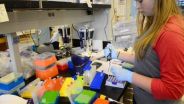(Press-News.org) A new, large cohort analysis from the prospective Prostate, Lung, Colorectal and Ovarian (PLCO) Cancer Screening Trial, indicates that men who had moderate baldness affecting both the front and the crown of their head at age 45 were at a 40% increased risk of developing aggressive prostate cancer (usually indicates a faster growing tumor resulting in poorer prognosis relative to non-aggressive prostate cancer) later in life, compared to men with no baldness. There was no significant link between other patterns of baldness and prostate cancer risk. The study, published September 15 in the Journal of Clinical Oncology, supports earlier research suggesting that male pattern baldness and prostate cancer may be linked.
"Our study found an increased risk for aggressive prostate cancer only in men with a very specific pattern of hair loss, baldness at the front and moderate hair-thinning on the crown of the head, at the age of 45. But we saw no increased risk for any form of prostate cancer in men with other hair-loss patterns," said senior study author Michael B. Cook, PhD, an investigator in the Division of Cancer Epidemiology and Genetics at the National Cancer Institute in Bethesda, MD. "While our data show a strong possibility for a link between the development of baldness and aggressive prostate cancer, it's too soon to apply these findings to patient care."
Prostate cancer is the second most common cancer among men. Emerging evidence suggests that prostate cancer and male pattern baldness—progressive scalp hair-loss in a distinct pattern—are both connected to increased levels of male sex hormones (androgens) and androgen receptors, supporting the idea of a biological link between baldness and prostate cancer development and progression.
Researchers analyzed male pattern baldness in relation to prostate cancer risk in a cohort of 39,070 men from the U.S. PLCO Cancer Screening Trial, aged 55-74 years at enrollment. The men received a questionnaire that asked them to recall what their hair-loss patterns were at age 45 using a pictorial tool.
During follow-up, 1,138 prostate cancer cases were diagnosed, 51% of which were aggressive (Gleason score equal to or greater than 7, stage III or IV, or prostate cancer as the cause of death). The mean age at the time of prostate cancer diagnosis was 72.
Men who had a specific pattern of baldness, frontal and moderate crown (vertex), were 40% more likely to develop aggressive prostate cancer, compared to men who had no baldness. There was no association between male pattern baldness and risk of non-aggressive prostate cancer.
Dr. Cook stated that if these findings are confirmed by further studies, medical assessment of baldness could possibly be used to help identify men who may be at increased risk of aggressive prostate cancer. His research team is currently conducting two additional cohort analyses exploring the relationship between male pattern baldness and risk of developing and dying from prostate cancer. One of the studies includes a baseline dermatologic assessment of male pattern baldness, which may be more reliable than the recall method, which was used in the present study.
This research was supported by the intramural program of the U.S. National Cancer Institute, National Institutes of Health.
ASCO Perspective
Charles Ryan, MD, ASCO expert
"Previous research linking baldness and prostate cancer has been inconclusive, but this large study suggests a significant link between high risk prostate cancer and hair loss - and suggests that men with hair loss may need to be followed more closely. More evidence is needed, however, before we can routinely consider baldness in prostate cancer screening recommendations."
INFORMATION:
In this News Digest:
A study being published online September 15, 2014 in the Journal of Clinical Oncology reports that men with a specific pattern of baldness at age 45 have a 40% increased risk of developing aggressive prostate cancer later in life, compared to men with no baldness at 45.
Quote for attribution to Charles Ryan, MD, American Society of Clinical Oncology Expert.
Links to additional information on Cancer.Net, ASCO's cancer information Website.
The Journal of Clinical Oncology is the tri-monthly peer-reviewed journal of the American Society of Clinical Oncology (ASCO), the world's leading professional society representing physicians who treat people with cancer.
ATTRIBUTION TO THE JOURNAL OF CLINICAL ONCOLOGY IS REQUESTED IN ALL NEWS COVERAGE.
Certain form of baldness at age 45 linked to higher risk of aggressive prostate cancer
2014-09-15
ELSE PRESS RELEASES FROM THIS DATE:
Researcher develops and proves effectiveness of new drug for spinal muscular atrophy
2014-09-15
COLUMBIA, Mo. – According to recent studies, approximately one out of every 40 individuals in the United States is a carrier of the gene responsible for spinal muscular atrophy (SMA), a neurodegenerative disease that causes muscles to weaken over time. Now, researchers at the University of Missouri have made a recent breakthrough with the development of a new compound found to be highly effective in animal models of the disease. In April, a patent was filed for the compound for use in SMA.
"The strategy our lab is using to fight SMA is to 'repress the repressor,'" said ...
EEG study findings reveal how fear is processed in the brain
2014-09-15
DALLAS, TX – September 12, 2014 - An estimated 8% of Americans will suffer from post traumatic stress disorder (PTSD) at some point during their lifetime. Brought on by an overwhelming or stressful event or events, PTSD is the result of altered chemistry and physiology of the brain. Understanding how threat is processed in a normal brain versus one altered by PTSD is essential to developing effective interventions.
New research from the Center for BrainHealth at The University of Texas at Dallas published online today in Brain and Cognition illustrates how fear arises ...
Smithsonian scientists discover tropical tree microbiome in Panama
2014-09-15
Human skin and gut microbes influence processes from digestion to disease resistance. Despite the fact that tropical forests are the most biodiverse terrestrial ecosystems on the planet, more is known about belly-button bacteria than bacteria on trees in the tropics. Smithsonian scientists and colleagues working on Panama's Barro Colorado Island discovered that small leaf samples from a single tree were home to more than 400 different kinds of bacteria. The combined sample from 57 tree species contained more than 7,000 different kinds.
Bacteria in tropical forests may ...
Scientists discover RNA modifications in some unexpected places
2014-09-15
CAMBRIDGE, Mass. (September 15, 2014) – The so-called central dogma of molecular biology—that DNA makes RNA which makes protein—has long provided a simplified explanation for how genetic information is deciphered and translated in living organisms.
In reality, of course, the process is vastly more complicated than the schema first articulated nearly 60 years ago by Nobel Laureate Francis Crick, co-discoverer of the DNA's double-helix structure. For one, there are multiple types of RNA, three of which—messenger RNA (mRNA), transfer RNA (tRNA), and ribosomal RNA (rRNA)—are ...
Study first to use brain scans to forecast early reading difficulties
2014-09-15
UC San Francisco researchers have used brain scans to predict how young children learn to read, giving clinicians a possible tool to spot children with dyslexia and other reading difficulties before they experience reading challenges.
In the United States, children usually learn to read for the first time in kindergarten and become proficient readers by third grade, according to the authors. In the study, researchers examined brain scans of 38 kindergarteners as they were learning to read formally at school and tracked their white matter development until third grade. ...
'Femme fatale' emerald ash borer decoy lures and kills males
2014-09-15
An international team of researchers has designed decoys that mimic female emerald ash borer beetles and successfully entice male emerald ash borers to land on them in an attempt to mate, only to be electrocuted and killed by high-voltage current.
"Our new decoy and electrocution process may be useful in managing what the U.S. Department of Agriculture Forest Service claims to be the most destructive forest pest ever seen in North America," said Michael Domingue, postdoctoral fellow in entomology, Penn State.
According to the Forest Service, the emerald ash borer was ...
Researchers control surface tension to manipulate liquid metals
2014-09-15
VIDEO:
Liquid metals have very large surface tensions that causes them to assume a spherical shape. Researchers have shown that the deposition of a surface oxide lowers the surface tension...
Click here for more information.
Researchers from North Carolina State University have developed a technique for controlling the surface tension of liquid metals by applying very low voltages, opening the door to a new generation of reconfigurable electronic circuits, antennas and other ...
Neuroscientists identify key role of language gene
2014-09-15
CAMBRIDGE, MA -- Neuroscientists have found that a gene mutation that arose more than half a million years ago may be key to humans' unique ability to produce and understand speech.
Researchers from MIT and several European universities have shown that the human version of a gene called Foxp2 makes it easier to transform new experiences into routine procedures. When they engineered mice to express humanized Foxp2, the mice learned to run a maze much more quickly than normal mice.
The findings suggest that Foxp2 may help humans with a key component of learning language ...
Network measures predict neuropsychological outcome after brain injury
2014-09-15
Cognitive neuroscience research has shown that certain brain regions are associated with specific cognitive abilities, such as language, naming, and decision-making.
How and where these specific abilities are integrated in the brain to support complex cognition is still under investigation. However, researchers at the University of Iowa and Washington University in St. Louis, Missouri, believe that several hub regions may be especially important for the brain to function as an integrated network.
In research published online Sept. 15 in the Early Edition of the Proceedings ...
Cells simply avoid chromosome confusion
2014-09-15
Reproductive cell division has evolved a simple, mechanical solution to avoid chromosome sorting errors, researchers report in the Sept. 11 Science Express.
This natural safeguard prevents incorrect chromosome counts and misalignments that lead to infertility, miscarriage, or congenital conditions.
"Mistakes during reproductive cell division cause these problems, but what exactly goes wrong is often not understood," said Adele Marston of the Wellcome Trust Center for Cell Biology at the University of Edinburgh in Scotland and lead author of the study. Understanding ...



